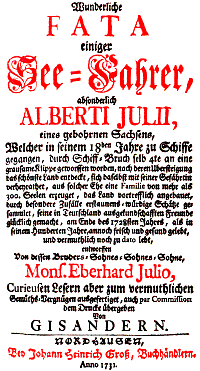Rock Castle Island
Insel Felsenburg is a novel by Johann Gottfried Schnabel , the four parts of which were published in 1731, 1732, 1736 and 1743 under the pseudonym Gisander in Nordhausen . The original title of the first part is completely:
“Strange fata of some seafarers, particularly Alberti Julii, a bored Saxon, who went to ships in his 18th year, was thrown onto a cruel cliff by ship breakage, after which the most beautiful country was discovered, there with himself Married companion, a family with more than 300 souls produced from such a marriage , the land excellently cultivated, astonishing treasures collected by special coincidences, his friends discovered in Germany happy, at the end of the 1728th year, than in its hundredth year Lived fresh and healthy, and presumably still lives to date , designed by his brother-son-son-son, Mons. Eberhard Julio, Curieusen readers, however, made out to the presumably emotional pleasure, also handed over to print par commission by Von Gisandern . "
The work, originally comprising around 2500 printed pages, was re-edited in an abridged version by Ludwig Tieck under the title Insel Felsenburg in 1828 and has become known under this title.
content
After the death of his mother and the bankruptcy of his father, the first-person narrator Eberhard Julius receives a letter from a captain Wolffgang in which he assures him that he will "more than double the damage suffered by her father ." Following the instructions in this letter, he travels to Amsterdam, where he meets the captain and learns from him that the island of Felsenburg is located in the South Sea, where his relative Albertus Julius rules as "grandfather". Together with some other representatives of useful professions, Eberhard Julius sets off for the island on the captain's ship. On the way they tell each other their life stories. When they arrive on the island, they are welcomed by 97-year-old Albert Julius, who tells them how he got to the island paradise when he was a shipwrecked boy, married the stranded Concordia Plürs and started a large family with her. which increased in the course of time by further castaways and abandoned people, and which has become very wealthy through the discovery of a buried treasure. Eberhard Julius and his companions travel the island, get to know how the rock burgers live together in an exemplary manner and decide to spend the rest of their lives on the island.
The second to fourth parts of the novel, which deal with the further fate of the island and its inhabitants after the death of Albertus Julius, are of constantly decreasing literary quality; the plot seems more and more arbitrary and pieced together and is filled with adventurous subplots and long theoretical insertions. Schnabel tried (which he admits at least for the fourth part) to use the great success of the novel financially through the sequels.
reception
The “Insel Felsenburg” combines the subgenre of the Robinsonade with the draft of an early Enlightenment and pietistic social utopia and strong criticism of the conditions in Europe at the beginning of the 18th century, which is particularly evident in the numerous inscribed lives of the people. In the 18th century the "Insel Felsenburg" was one of the most popular novels of all, but was largely forgotten at the turn of the 19th century . Only the tightening and linguistically modernizing treatment by Ludwig Tieck in 1828 brought the work back into public awareness.
expenditure
- Johann Gottfried Schnabel: Strange fata of some seafarers ... 4 volumes. Frankfurt / Hildesheim: Minerva / Olms 1973. (photomechanical reprint of the original edition)
- Johann Gottfried Schnabel: Island rock castle. Ditzingen: Reclam 1994 (RUB 8421), ISBN 978-3-15-008421-2
- Johann Gottfried Schnabel: Island rock castle. Strange fata of some seafarers. 3 volumes. With an afterword by Günter Dammann. Text editing by Marcus Czerwionka with the assistance of Robert Wohlleben . Frankfurt: Zweiausendeins 1997 (Haidnian Altherthümer), ISBN 3-861-50171-6 (Complete new edition of the original version with a commentary)
literature
- Arno Schmidt : Mr. Schnabel's trail. From the law of the Tristanites . In: Arno Schmidt: Bargfelder Edition, group of works II, Volume 1, pp. 235–264. Haffmans, Zurich 1990. ISBN 3-251-80021-3 (first: 1958)
- Fritz Brüggemann : Utopia and Robinsonade . Investigations into Schnabel's island rock castle (1731–1743) . A. Duncker, Weimar 1914; Reprography: Gerstenberg, Hildesheim 1978, ISBN 3-8067-0636-0 .
- Gerhard Dünnhaupt : Johann Gottfried Schnabel . In: Bibliographisches Handbuch zu den Druck des Barock , Vol. 5. Stuttgart: Hiersemann 1991, pp. 3686–3695 (with bibliography). ISBN 3-7772-9133-1
- Günter Dammann : About JG Schnabel. Searching for traces, the plots of the novels and the work on meaning . In: Johann Gottfried Schnabel: Insel Felsenburg. Strange fata of some seafarers. Appendix . Frankfurt am Main: Two thousand and one 1997 ( Haidnian antiquities ), 313 pages. ISBN 3-86150-171-6
- Heidi Nenoff: Discourse on religion and natural law in Johann Gottfried Schnabel's miraculous FATA of some seafarers. Leipziger Universitätsverlag, Leipzig 2016, ISBN 978-3-96023-010-6 .
Web links
- E-text at zeno.org
- E-text for the Gutenberg-DE project
- Edition of the Insel Felsenburg von Tieck (PDF, 33 MByte); Reprint in the Arno Schmidt reference library
- To the rock castle island

